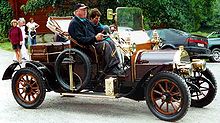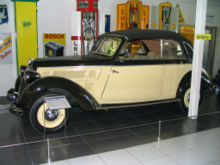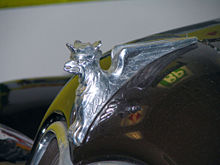
Stoewer
Encyclopedia

Germany
Germany , officially the Federal Republic of Germany , is a federal parliamentary republic in Europe. The country consists of 16 states while the capital and largest city is Berlin. Germany covers an area of 357,021 km2 and has a largely temperate seasonal climate...
automobile
Automobile
An automobile, autocar, motor car or car is a wheeled motor vehicle used for transporting passengers, which also carries its own engine or motor...
manufacturer before World War II
World War II
World War II, or the Second World War , was a global conflict lasting from 1939 to 1945, involving most of the world's nations—including all of the great powers—eventually forming two opposing military alliances: the Allies and the Axis...
whose headquarters were in Stettin (Szczecin)
Szczecin
Szczecin , is the capital city of the West Pomeranian Voivodeship in Poland. It is the country's seventh-largest city and the largest seaport in Poland on the Baltic Sea. As of June 2009 the population was 406,427....
.
The first company was founded by the Stoewer brothers, Emil (lived 1873 - 1942) and Bernhard (1875 - 1937) in 1896 for manufacturing sewing machine
Sewing machine
A sewing machine is a textile machine used to stitch fabric, cards and other material together with thread. Sewing machines were invented during the first Industrial Revolution to decrease the amount of manual sewing work performed in clothing companies...
s in Stettin. In 1899, the Stoewer brothers founded the firm Gebrüder Stoewer, Fabrik für Motorfahrzeugen and started to produce automobiles. Their first automobile
Automobile
An automobile, autocar, motor car or car is a wheeled motor vehicle used for transporting passengers, which also carries its own engine or motor...
was the Grosser Motorwagen (Large Motor Car), with 6.5 hp (4.8 kW) and 17 kilometre per hour maximum speed.

Mathis
Mathis was a firm in Alsace that produced cars between 1910 and 1950, founded by Émile Mathis born Strasbourg , died Geneva.-Hermès-Simplex:...
of Strassburg.
In 1916, the family-owned company was transformed into a limited company under the name of Stoewer-Werke AG, vormals Gebrüder Stoewer.
In the mid-20's a new class of cars was introduced: the D-Types included D3, D9 and D10 with four-cylinder engines, as well as D5, D6 and D12 with six cylinders.
Something special was in 1921 class D7 with a proprietary six cylinder aero engine with 120 hp. It was the strongest car in those days.

At the beginning of the 1930s Stoewers delivered their highlights: G15 Gigant, M12 Marschall and P20 Repräsentant, each with eight cylinder engines, with 60 to 120 hp (45 to 90 kW) and 130 kilometre per hour maximum speed. The production of these cars had to be cancelled after 2,500 vehicles being produced due to worldwide economic troubles. In 1931 Stoewer constructed one of the first cars with front-wheel drive
Front-wheel drive
Front-wheel drive is a form of engine/transmission layout used in motor vehicles, where the engine drives the front wheels only. Most modern front-wheel drive vehicles feature a transverse engine, rather than the conventional longitudinal engine arrangement generally found in rear-wheel drive and...
at all, class V5 25 hp (19 kW), 80 kilometre per hour maximum speed. The model named Greif Junior was built under the licence of Tatra
Tatra (car)
Tatra is a vehicle manufacturer in Kopřivnice, Czech Republic. The company was founded in 1850 as Schustala & Company later renamed Nesselsdorfer Wagenbau-Fabriksgesellschaft, a wagon and carriage manufacturer, and in 1897 produced the first motor car in central Europe, the Präsident. In 1918, it...
. Its afterdecessor V8 Greif was the last car being constructed by Mr Stoewer itself, class Arkona and Sedina were the last civilian cars produced by the company.
With the beginning of World War II
World War II
World War II, or the Second World War , was a global conflict lasting from 1939 to 1945, involving most of the world's nations—including all of the great powers—eventually forming two opposing military alliances: the Allies and the Axis...
, Stoewer factory started to produce cars for the Wehrmacht
Wehrmacht
The Wehrmacht – from , to defend and , the might/power) were the unified armed forces of Nazi Germany from 1935 to 1945. It consisted of the Heer , the Kriegsmarine and the Luftwaffe .-Origin and use of the term:...
as LEPKW class (Leichter Einheits-Personenkraftwagen, or Small Unit-Personnel Carrier). A versatile 4-wheel-drive car, many equipped with 4-wheel-steering. Capacity-problems led to co-production by BMW
BMW
Bayerische Motoren Werke AG is a German automobile, motorcycle and engine manufacturing company founded in 1916. It also owns and produces the Mini marque, and is the parent company of Rolls-Royce Motor Cars. BMW produces motorcycles under BMW Motorrad and Husqvarna brands...
and Hanomag
Hanomag
Hanomag was a German producer of steam locomotives, tractors, trucks and military vehicles. Hanomag first achieved international fame by delivering a large number of steam locomotives to Romania and Bulgaria before World War I....
, under parentage of Stoewer. Together the three manufacturers made a total of ca. 10.000 units. After World War II
World War II
World War II, or the Second World War , was a global conflict lasting from 1939 to 1945, involving most of the world's nations—including all of the great powers—eventually forming two opposing military alliances: the Allies and the Axis...
, the Red Army
Red Army
The Workers' and Peasants' Red Army started out as the Soviet Union's revolutionary communist combat groups during the Russian Civil War of 1918-1922. It grew into the national army of the Soviet Union. By the 1930s the Red Army was among the largest armies in history.The "Red Army" name refers to...
seized the remaining production facilities, dismantled them and sent to the Soviet Union
Soviet Union
The Soviet Union , officially the Union of Soviet Socialist Republics , was a constitutionally socialist state that existed in Eurasia between 1922 and 1991....
. The days of car manufacturing in this famous factory were over.
Passenger car models
| Type | Construction period | Cylinder | Capacity | Power | Vmax |
|---|---|---|---|---|---|
| 10 PS | 1901–1902 | straight-2 | 1.527 cc | 18 PS (13,2 kW) | 50 kilometre per hour |
| 8/14 PS | 1902–1905 | straight-2 | 1.527 cc | 14 PS (10,3 kW) | 50 kilometre per hour |
| 20 PS | 1904–1905 | straight-4 | 7.946 cc | 45 PS (33 kW) | 85 kilometre per hour |
| P4 (11/22 PS) | 1905–1910 | straight-4. | 3.054 cc | 22 PS (16,2 kW) | 70 kilometre per hour |
| P2 (9/12 PS) | 1906–1907 | straight-2 | 2.281 cc | 16 PS (11,8 kW) | 55 kilometre per hour |
| P4-1 (24/36 PS) | 1906–1910 | straight-4 | 5.880 cc | 40 PS (29 kW) | 80 kilometre per hour |
| P6 (34/60 PS) | 1906–1911 | straight-6 | 8.820 cc | 60 PS (44 kW) | 95 kilometre per hour |
| G4 (6/12 PS) | 1907–1911 | straight-4 | 1.500 cc | 12 PS (8,8 kW) | 60 kilometre per hour |
| PK4 (11/20 PS) | 1909–1912 | straight-4 | 2.544 cc | 20 PS (14,7 kW) | 70 kilometre per hour |
| C1 (6/18 PS) | 1909–1915 | straight-4 | 1.546 cc | 18 PS (13,2 kW) | 70 kilometre per hour |
| B1 (6/16 PS) | 1910–1912 | straight-4 | 1.556 cc | 16 PS (11,8 kW) | 65 kilometre per hour |
| B6 (9/22 PS) | 1912–1914 | straight-4 | 4.900 cc | 45 PS (33 kW) | 95 kilometre per hour |
| C2 (10/28 PS) | 1913–1914 | straight-4 | 2.412 cc | 28 PS (20,6 kW) | 75 kilometre per hour |
| C5 (6/18 PS) | 1915–1919 | straight-4 | 1.546 cc | 15 PS (11 kW) | 70 kilometre per hour |
| D2 (6/18 PS) | 1919–1920 | straight-4 | 1.593 cc | 18 PS (13,2 kW) | 70 kilometre per hour |
| D6 (19/55 PS) | 1919–1921 | straight-6 | 4.960 cc | 55 PS (40 kW) | 100 kilometre per hour |
| D7 (42/120 PS) | 1919–1921 | straight-6 | 11.160 cc | 120 PS (88 kW) | 160 kilometre per hour |
| D3 (8/24 PS) | 1920–1923 | straight-4 | 2.120 cc | 24 PS (17,6 kW) | 70 kilometre per hour |
| D5 (12/36 PS) | 1920–1923 | straight-6 | 3.107 cc | 36 PS (26,5 kW) | 80 kilometre per hour |
| D9 (8/32 PS) | 1923–1924 | straight-4 | 2.290 cc | 32 PS (23,5 kW) | 90 kilometre per hour |
| D12 (12/45 PS) | 1923–1924 | straight-6 | 3.107 cc | 45 PS (33 kW) | 100 kilometre per hour |
| D10 (10/50 PS) | 1924–1925 | straight-4 | 2.580 cc | 50 PS (37 kW) | 120 kilometre per hour |
| D9V (9/32 PS) | 1925–1927 | straight-4 | 2.290 cc | 32 PS (23,5 kW) | 90 kilometre per hour |
| D12V (13/55 PS) | 1925–1928 | straight-6 | 3.386 cc | 55 PS (40 kW) | 100 kilometre per hour |
| F6 (6/30 PS) | 1927–1928 | straight-4 | 1.570 cc | 30 PS (22 kW) | 70 kilometre per hour |
| 8 Typ S 8 (8/45 PS) | 1928 | straight-8 | 1.999 cc | 45 PS (33 kW) | 85 kilometre per hour |
| 8 Typ G 14 (14/70 PS) | 1928 | straight-8 | 3.633 cc | 70 PS (51 kW) | 100 kilometre per hour |
| 8 Typ S 10 (10/50 PS) | 1928–1930 | straight-8 | 2.464 cc | 50 PS (37 kW) | 90 kilometre per hour |
| Gigant G 15 K (15/80 PS) | 1928–1933 | straight-8 | 3.974 cc | 80 PS (59 kW) | 110 kilometre per hour |
| Gigant G 15 (15/80 PS) | 1928–1933 | straight-8 | 3.974 cc | 80 PS (59 kW) | 100 kilometre per hour |
| Repräsentant P 20 (20/100 PS) | 1930–1933 | straight-8 | 4.906 cc | 100 PS (74 kW) | 120 kilometre per hour |
| Marschall M 12 (12/60 PS) | 1930–1934 | straight-8 | 2.963 cc | 60 PS (44 kW) | 90 kilometre per hour |
| V 5 | 1931–1932 | V4 | 1.168 cc | 25 PS (18,4 kW) | 80 kilometre per hour |
| V 5 Sport | 1931–1932 | V4 | 1.168 cc | 30 PS (22 kW) | 100 kilometre per hour |
| R 140 | 1932–1933 | straight-4 | 1.355 cc | 30 PS (22 kW) | 85 kilometre per hour–105 kilometre per hour |
| R 140 | 1933–1934 | straight-4 | 1.466 cc | 30 PS (22 kW) | 85 kilometre per hour–105 kilometre per hour |
| R 150 | 1934–1935 | straight-4 | 1.466 cc | 35 PS (25,7 kW) | 90–110 km/h |
| Greif V8 | 1934–1937 | V8 | 2.489 cc | 55 PS (40 kW) | 110 kilometre per hour |
| R 180 | 1935 | straight-4 | 1.769 cc | 45 PS (33 kW) | 105 kilometre per hour |
| Greif V8 Sport | 1935–1937 | V8 | 2.489 cc | 57 PS (42 kW) | 120 kilometre per hour |
| Greif Junior | 1936–1939 | flat-4 | 1.484 cc | 34 PS (25 kW) | 100 kilometre per hour |
| Sedina | 1937–1940 | straight-4 | 2.406 cc | 55 PS (40 kW) | 110 kilometre per hour |
| Arkona | 1937–1940 | straight-6 | 3.610 cc | 80 PS (59 kW) | 120 kilometre per hour–140 kilometre per hour |

